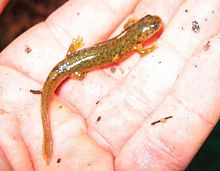Rhyacotritonidae
Torrent salamander
Family of amphibians
The torrent salamanders or Cascade salamanders are a family of salamanders (Rhyacotritonidae) with only one genus, Rhyacotriton. The torrent salamanders have highly reduced lungs and are endemic to the United States in the Pacific Northwest (including northwestern California).[1][2]
This article needs additional citations for verification. (September 2019) |
| Torrent salamanders | |
|---|---|
 | |
| Rhyacotriton variegatus | |
| Scientific classification | |
| Domain: | Eukaryota |
| Kingdom: | Animalia |
| Phylum: | Chordata |
| Class: | Amphibia |
| Order: | Urodela |
| Suborder: | Salamandroidea |
| Family: | Rhyacotritonidae Tihen, 1958 |
| Genus: | Rhyacotriton Dunn, 1920 |
| Species | |
|
Rhyacotriton cascadae (blue) | |
 | |
Maximum adult snout-vent length is 6 cm. They have complete metamorphosis, but a few neotenic traits have been found, like the presence of conical teeth and reduced or absent nasal bones. Nasal bones have never been seen in R. olympicus. but are present in some specimens of the other species, and occurs most often in R. variegatus. The lungs are minute; in R. olympicus they are 5 to 7 mm in length, but highly vascular and filled with air. They are very sensitive to desiccation and warm temperatures. More than 83 °F (28 °C) can be fatal, and they can only tolerate a water loss of 19.4 percent of initial body weight at most (compared to 29.0 to 32.9 percent for other species). Because of this, they are rarely found more than a meter away from free-running water. On rare occasions adults can be found under objects a few meters from water after heavy rain.[3][4][5][6] Males have a unique vent gland.[7]
Courtship is terrestrial. The male will deposit a spermatophore on the ground, which is then picked up by the female.[8] The eggs have a pale yellow-white ova, and are deposited separately and haphazardly in slow-flowing water. Sometimes communal oviposition occurs.[9] They are attached neither to each other or to the substrate, which is unique in salamanders. Parental care is absent.[10]
The genus Rhyacotriton includes four species:
- Cascade torrent salamander (R. cascadae)
- Columbia torrent salamander (R. kezeri)
- Olympic torrent salamander (R. olympicus)
- Southern torrent salamander (R. variegatus)
Originally the genus Rhyacotriton was placed in the family Ambystomatidae, later in the family Dicamptodontidae, and finally in 1992 it was placed into a family of its own. At the same time the only species Rhyacotriton olympicus was split into four species due to genetic analysis.
- Rose, C. S.; James, B. (2013). "Plasticity of lung development in the amphibian, Xenopus laevis". Biology Open. 2 (12): 1324–1335. doi:10.1242/bio.20133772. PMC 3863417. PMID 24337117.